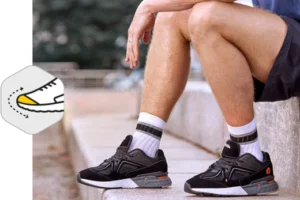Living with diabetes means taking extra care of your feet, especially when it comes to the shoes you wear every day. Wide diabetic shoes are designed to reduce pressure, prevent irritation, and support proper circulation—making them essential for anyone managing diabetes, neuropathy, swelling, or foot deformities like bunions and hammertoes.
This guide walks you through what wide diabetic shoes do, why they matter, and how to choose the right pair for total daily comfort.
Why Wide Diabetic Shoes Matter
1. Reduced Pressure on Sensitive Areas
Diabetic feet are prone to pressure points that can quickly turn into sores or ulcers. Wide diabetic shoes provide extra space in the forefoot and midfoot, allowing your toes to spread naturally. This reduces compression, friction, and skin breakdown.
2. Better Circulation and Reduced Swelling
Many people with diabetes experience edema. A wide-fit shoe gives the feet room to expand throughout the day without squeezing or cutting into the skin.
3. Protection Against Irritation
Diabetic-friendly designs typically include seam-free interiors, soft linings, and extra padding. This helps prevent rubbing and blisters—common problems that can become serious if unnoticed due to neuropathy.
4. Stability for Safer Walking
A wider base improves balance and makes walking more secure. Combined with diabetic-specific cushioning, this reduces joint stress and helps prevent falls.
Key Features to Look For
Extra Depth
Deep toe boxes help accommodate swelling, custom orthotics, hammertoes, or bandaging. This prevents skin rubbing and gives your feet room to breathe.
Flexible Uppers
Soft stretch materials or premium leather allow movement without pressure. They adapt to changing foot shape, especially important for neuropathy or deformities.
Supportive Insoles
High-quality insoles should provide arch support, cradle the heel, and absorb impact. Cushioning reduces strain on your midfoot and joints, especially if you walk or stand for long periods.
Firm Heel Counter
A structured heel helps keep your foot aligned, prevents pronation, and improves stability. This is important for reducing pain and maintaining healthy gait patterns.
Slip-Resistant Outsoles
People with diabetes benefit from shoes with sturdy traction to prevent slips and falls. A good outsole also supports proper shock absorption.
Adjustable Closures
Velcro straps, elastic uppers, or laces allow you to customize the fit—especially helpful for swelling that comes and goes.
Benefits of Wearing the Right Wide Diabetic Shoes
Comfort That Lasts All Day
You should feel immediate ease when putting on a diabetic shoe. The roomy fit and cushioned sole ensure both comfort and reduced fatigue.
Reduced Risk of Ulcers
Proper footwear significantly decreases the chances of developing sores, especially in pressure-prone areas like the toes, heels, and sides of the foot.
Improved Posture and Joint Health
Good support improves alignment, making walking easier on your knees, hips, and lower back.
Better Mobility and Confidence
With the right shoes, movement becomes pain-free, stable, and enjoyable again—helping you stay active and independent.
How to Choose the Right Fit
Measure Your Feet Regularly
Diabetic feet can change shape over time. Check your size and width yearly, or whenever you notice discomfort.
Try Shoes Later in the Day
Feet swell throughout the day, so try shoes when your feet are at their largest.
Check for Interior Seam-Free Construction
Your hand should glide smoothly inside the shoe. Any rough stitching could cause irritation.
Ensure Enough Toe Wiggle Room
Your toes shouldn’t touch the front or sides. Aim for about a thumb’s width of space at the front.
Test the Flex
The shoe should flex at the forefoot—not the arch or heel.
When to Consider Extra-Wide or XX-Wide Fits
You may need a wider-than-standard diabetic shoe if you experience:
-
Chronic swelling
-
Bunions or hammertoes
-
Neuropathy with numbness or burning
-
High insteps
-
Custom orthotics that require extra space
-
Overlapping toes
Choosing a wider fit ensures comfort and prevents pressure-related complications.
Caring for Your Wide Diabetic Shoes
To keep your shoes performing well:
-
Rotate between two pairs to prolong lifespan
-
Air-dry shoes after wear to prevent moisture buildup
-
Replace insoles every few months
-
Inspect the interior regularly for debris or worn areas
-
Never walk barefoot, even indoors—protect your feet at all times
Final Thoughts
Wide diabetic shoes are more than just footwear—they’re an essential tool for keeping your feet healthy, comfortable, and protected. The right pair can dramatically improve your daily mobility, reduce pain, and prevent complications associated with diabetes. Focus on shoes that offer depth, support, softness, and stable cushioning, and your feet will thank you every step of the way.



